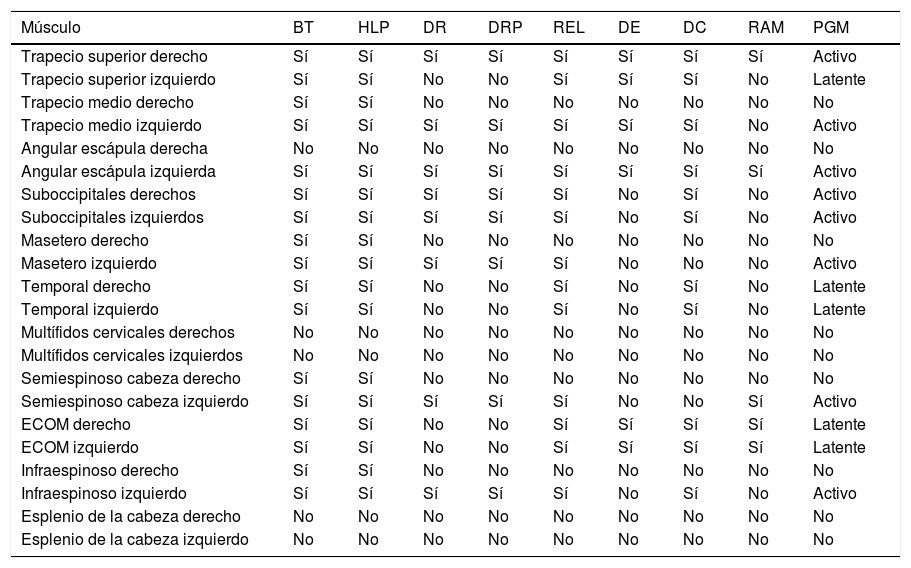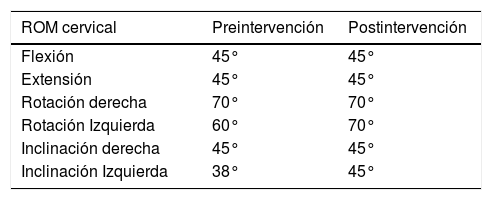La cefalea tensional tiene una prevalencia importante y un fuerte impacto socioeconómico. Se considera un síndrome de dolor miofascial. El tratamiento del síndrome de dolor miofascial en la musculatura cervical posterior y craneal puede ser una alternativa al tratamiento farmacológico en el abordaje de la cefalea tensional.
ObjetivoDescribir la presencia del síndrome de dolor miofascial en una paciente diagnosticada de cefalea tensional y determinar la efectividad de un tratamiento fisioterapéutico.
Materiales y métodosMujer de 60 años diagnosticada de cefalea tensional. Presentaba un cuadro de dolor opresivo de localización bilateral en cabeza, así como dolor y rigidez cervical. Se exploraron 23 músculos de la zona craneocervical y escapular para diagnosticar el síndrome del dolor miofascial y tratar los puntos gatillo mediante punción seca y el abordaje de Dejung. Se midió el rango articular cervical mediante goniometría y se evaluó el dolor de cabeza con la escala analógica visual del dolor.
ResultadosEl diagnóstico del síndrome del dolor miofascial se confirmó por la presencia de 8 puntos gatillo miofasciales activos. Los resultados mostraron una mejoría clínica relevante en la variable intensidad del dolor, con una reducción superior al 25% en todas las mediciones excepto la tercera. Esta mejora se mantuvo 2 semanas después del tratamiento. Al final de la intervención el dolor remitió, desaparecieron todos los puntos gatillo iniciales activos y latentes, y se recuperaron los últimos grados de ROM para la rotación e inclinación cervical izquierda.
ConclusionesEl diagnóstico y abordaje del síndrome del dolor miofascial debe ser considerado en pacientes con cefalea tensional.
Tension headache has an important prevalence and a strong socioeconomic impact. It is considered a myofascial pain syndrome. The treatment of myofascial pain syndrome in the posterior cervical and cranial muscles can be an alternative to pharmacological treatment in the management of tension headache.
ObjectiveTo describe the presence of myofascial pain syndrome in a patient diagnosed with tension headache, as well as determine the effectiveness of a physiotherapeutic treatment.
Materials and methodsA 60-year-old woman diagnosed with tension headache. The patient presented a condition of oppressive bilateral headache, as well as neck pain and stiffness. Twenty-three muscles were scanned from the cranio-cervical and scapular area to diagnose myofascial pain syndrome and to treat the trigger points through dry needling and Dejung's technique. Cervical joint range of motion was measured by goniometry and headache was assessed with the visual analogue scale for pain.
ResultsThe diagnosis of myofascial pain syndrome was confirmed by the presence of 8 active myofascial trigger points. The results showed a relevant clinical improvement in the pain intensity variable, with a reduction of more than 25% in all measurements except in the third one. This improvement was maintained 2 weeks after the treatment. At the end of the intervention, the pain remitted, all the active and latent initial trigger points disappeared, and the last degrees of ROM were recovered for left cervical rotation and tilt.
ConclusionsThe diagnosis and approach of myofascial pain syndrome should be considered in patients with tension headache.
Article
Si ya tiene sus datos de acceso, clique aquí.
Si olvidó su clave de acceso puede recuperarla clicando aquí y seleccionando la opción "He olvidado mi contraseña".








